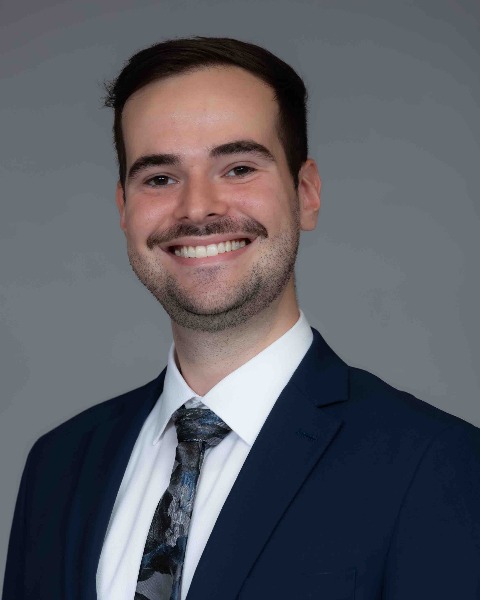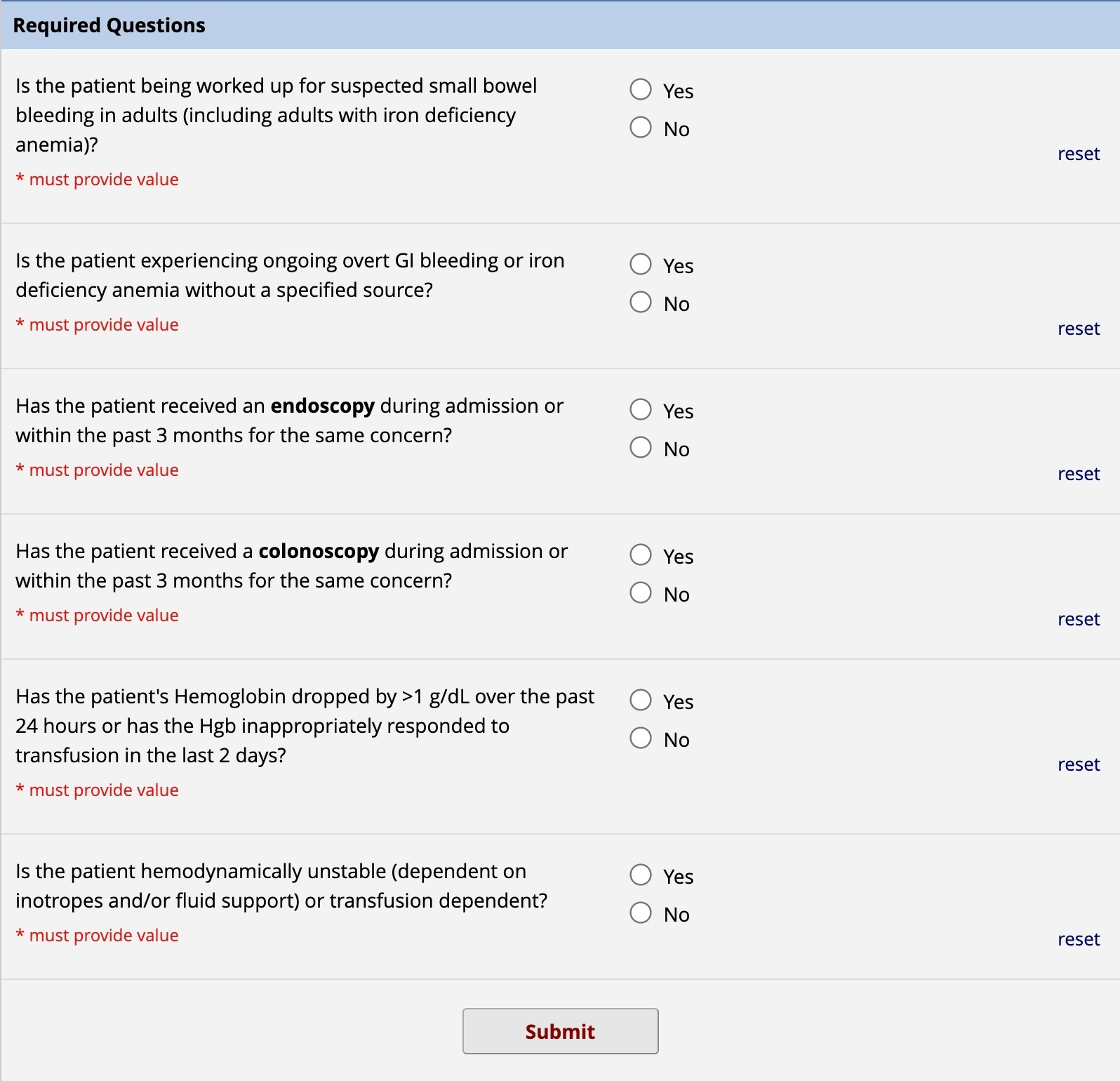Tuesday Poster Session
Category: GI Bleeding
P4171 - Inpatient Video Capsule Endoscopy Yield Increases After Implementation of Screening Form
Tuesday, October 29, 2024
10:30 AM - 4:00 PM ET
Location: Exhibit Hall E

Has Audio

Leo Kleyman, MD
Baylor College of Medicine
Miami, FL
Presenting Author(s)
Leo Kleyman, MD1, Matei Caleap, BS2, Hany Atallah, MD3, Sunil Amin, MD, MPH2, Ami Panara Shukla, MD4
1Baylor College of Medicine, Miami, FL; 2University of Miami Miller School of Medicine, Miami, FL; 3Jackson Health System, Miami, FL; 4University of Miami Miller School of Medicine at Jackson Memorial Hospital, Miami, FL
Introduction: Inpatient video capsule endoscopy (VCE) is a useful adjunct to upper and lower endoscopy in patients with obscure overt gastrointestinal bleeding (OGIB). VCE yield is higher when performed closer to onset of OGIB; therefore, delays in placement will decrease therapeutic yield. At our urban tertiary care county hospital, inpatient VCE's are approved by perioperative and hospital leadership to ensure appropriate use of resources. However, these physicians are not GI-trained and therefore voiced concern in their ability to make timely and appropriate recommendations. We partnered with the chief medical officer (CMO) to implement a screening form to identify proper candidates for inpatient VCE.
Methods: Our study population includes adults being considered for inpatient VCE. With the new process, providers requesting inpatient VCE fill out an online screening form, and the procedure is automatically approved if all criteria are met (Figure 1). Unapproved cases are reviewed on a case-by-case basis by the CMO, as in the previous model. We conducted a preliminary analysis six months after form implementation and compared these results to VCE's done in the twelve months prior to for implementation (baseline).
Results: Our baseline cohort included 19 VCE’s, and our form group included 6 of 12 requested VCE’s that were approved and deployed (Table 1). In the baseline cohort, none of the VCE’s captured active bleeding or led to follow-up therapeutic interventions. In the form group, active bleeding was seen in 3 (50%) VCE's; with therapeutic interventions performed in 2 (33%). Both interventions were done after discharge. VCE's in the form cohort were done sooner after onset of OGIB and had shorter LOS after deployment. Most VCE's in both cohorts were performed > 72 hours after onset of OGIB. In an initial cost analysis, patients that were discharged before results or without downstream procedures cost the hospital an estimated $1726 when considering cost of VCE equipment and increased inpatient LOS.
Discussion: There is a trend towards increased diagnostic and therapeutic yield, quicker deployment, and shorter LOS in VCE's from the form cohort compared to the baseline cohort. Limitations include the small sample size. Our next steps include analysis at 12 months, educating providers on improving yield of inpatient VCE by minimizing delays in deployment and creating a protocol for scheduling and approval of outpatient VCE within a week of discharge for selected inpatients.

Note: The table for this abstract can be viewed in the ePoster Gallery section of the ACG 2024 ePoster Site or in The American Journal of Gastroenterology's abstract supplement issue, both of which will be available starting October 27, 2024.
Disclosures:
Leo Kleyman, MD1, Matei Caleap, BS2, Hany Atallah, MD3, Sunil Amin, MD, MPH2, Ami Panara Shukla, MD4. P4171 - Inpatient Video Capsule Endoscopy Yield Increases After Implementation of Screening Form, ACG 2024 Annual Scientific Meeting Abstracts. Philadelphia, PA: American College of Gastroenterology.
1Baylor College of Medicine, Miami, FL; 2University of Miami Miller School of Medicine, Miami, FL; 3Jackson Health System, Miami, FL; 4University of Miami Miller School of Medicine at Jackson Memorial Hospital, Miami, FL
Introduction: Inpatient video capsule endoscopy (VCE) is a useful adjunct to upper and lower endoscopy in patients with obscure overt gastrointestinal bleeding (OGIB). VCE yield is higher when performed closer to onset of OGIB; therefore, delays in placement will decrease therapeutic yield. At our urban tertiary care county hospital, inpatient VCE's are approved by perioperative and hospital leadership to ensure appropriate use of resources. However, these physicians are not GI-trained and therefore voiced concern in their ability to make timely and appropriate recommendations. We partnered with the chief medical officer (CMO) to implement a screening form to identify proper candidates for inpatient VCE.
Methods: Our study population includes adults being considered for inpatient VCE. With the new process, providers requesting inpatient VCE fill out an online screening form, and the procedure is automatically approved if all criteria are met (Figure 1). Unapproved cases are reviewed on a case-by-case basis by the CMO, as in the previous model. We conducted a preliminary analysis six months after form implementation and compared these results to VCE's done in the twelve months prior to for implementation (baseline).
Results: Our baseline cohort included 19 VCE’s, and our form group included 6 of 12 requested VCE’s that were approved and deployed (Table 1). In the baseline cohort, none of the VCE’s captured active bleeding or led to follow-up therapeutic interventions. In the form group, active bleeding was seen in 3 (50%) VCE's; with therapeutic interventions performed in 2 (33%). Both interventions were done after discharge. VCE's in the form cohort were done sooner after onset of OGIB and had shorter LOS after deployment. Most VCE's in both cohorts were performed > 72 hours after onset of OGIB. In an initial cost analysis, patients that were discharged before results or without downstream procedures cost the hospital an estimated $1726 when considering cost of VCE equipment and increased inpatient LOS.
Discussion: There is a trend towards increased diagnostic and therapeutic yield, quicker deployment, and shorter LOS in VCE's from the form cohort compared to the baseline cohort. Limitations include the small sample size. Our next steps include analysis at 12 months, educating providers on improving yield of inpatient VCE by minimizing delays in deployment and creating a protocol for scheduling and approval of outpatient VCE within a week of discharge for selected inpatients.

Figure: Figure 1: Physician’s view of screening form. The form is approved if the physician answers “yes” to questions 1-4 and “yes” to questions 5 and/or 6.
Note: The table for this abstract can be viewed in the ePoster Gallery section of the ACG 2024 ePoster Site or in The American Journal of Gastroenterology's abstract supplement issue, both of which will be available starting October 27, 2024.
Disclosures:
Leo Kleyman indicated no relevant financial relationships.
Matei Caleap indicated no relevant financial relationships.
Hany Atallah indicated no relevant financial relationships.
Sunil Amin: 3D Matrix – Consultant. Boston Scientific – Consultant. Medtronic – Consultant.
Ami Panara Shukla indicated no relevant financial relationships.
Leo Kleyman, MD1, Matei Caleap, BS2, Hany Atallah, MD3, Sunil Amin, MD, MPH2, Ami Panara Shukla, MD4. P4171 - Inpatient Video Capsule Endoscopy Yield Increases After Implementation of Screening Form, ACG 2024 Annual Scientific Meeting Abstracts. Philadelphia, PA: American College of Gastroenterology.
